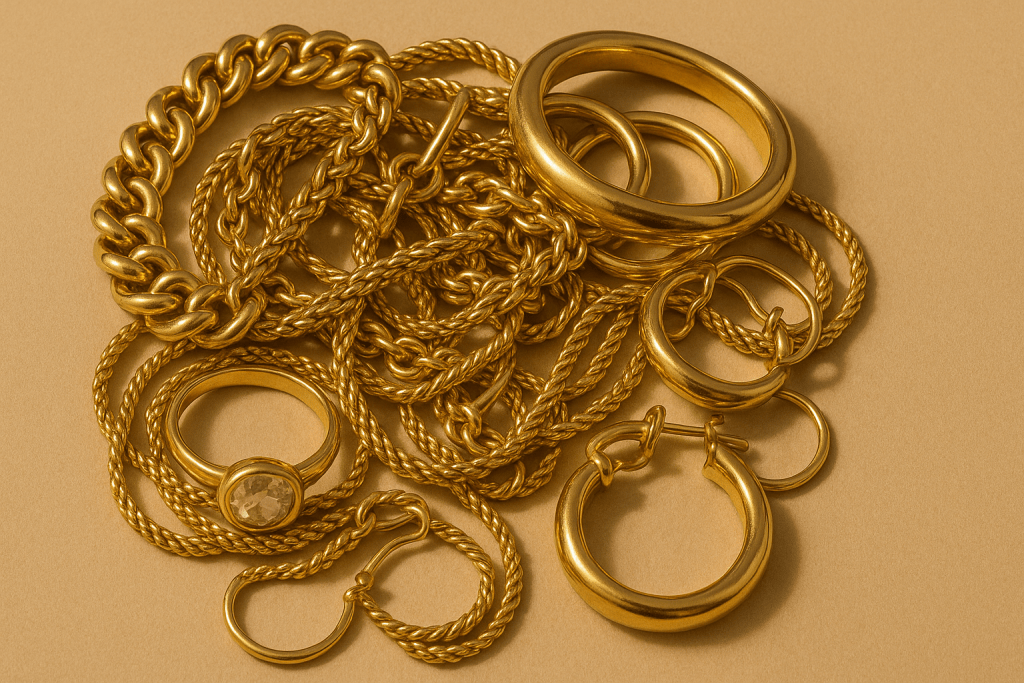How to Tell If Gold Is Real: A Complete Guide
Gold has been prized for centuries, not only for its beauty but also for its value. However, with so many counterfeit and gold-plated items on the market, it’s important to know how to tell if gold is real before buying or selling.
At Stewart Kuper Jewelers, we specialize in evaluating gold jewelry and ensuring that sellers get a fair price. Whether you’re checking an old family heirloom or confirming the authenticity of a recent purchase, here’s how you can determine if your gold is real.
1. Check for Hallmarks
One of the easiest ways to tell if gold is real is by looking for a hallmark—a small stamp indicating the purity of the gold. In the U.S., these stamps typically include:
- 10K, 14K, 18K, or 24K (indicating gold purity in karats)
- “750,” “585,” or “417” (European markings that represent gold percentage)
- “GF” or “GP” (Gold-Filled or Gold-Plated, meaning it’s not solid gold)
A genuine gold piece should have a clearly stamped hallmark, but keep in mind that older or worn-down jewelry may have faded markings.
2. Perform the Magnet Test
Gold is not magnetic, so a quick test with a strong magnet can help determine if your piece contains real gold.
How to do it:
- Hold a strong magnet (such as a neodymium magnet) close to your gold item.
- If the gold is attracted to the magnet, it likely contains other metals or is fake.
- If it doesn’t react, it might be real gold—but further testing is recommended.
Keep in mind that some non-gold metals are also non-magnetic, so this test alone isn’t foolproof.
3. Conduct the Acid Test
This is one of the most reliable tests for determining real gold but should be done carefully and is safest done by a professional.
How to do it:
- Purchase a gold testing kit with nitric acid.
- Scratch a small part of the gold on a testing stone.
- Apply a drop of nitric acid and observe the reaction:
- No reaction? Your gold is real.
- Green or milky white reaction? It’s fake or gold-plated.
- No reaction? Your gold is real.
Because nitric acid is a hazardous substance, we recommend having a professional jeweler perform this test.
4. Look for Discoloration and Tarnishing
Unlike other metals, pure gold does not tarnish or rust. If your jewelry shows signs of discoloration, fading, or greenish residue (especially where it rubs against the skin), it is likely gold-plated or fake.
Common signs of fake gold include:
- Peeling or chipping: Indicates a gold-plated coating wearing off.
- Green or black tarnish: Suggests non-gold metals underneath.
- Color changes in worn areas: Means the gold layer is thin and revealing a base metal.
Real gold retains its color and luster over time, regardless of wear.
5. Take It to a Professional Jeweler
If you’re unsure about the authenticity of your gold, the best way to verify it is by bringing it to a trusted jeweler. Professional jewelers use:
- Electronic gold testers to check metal composition.
- X-ray fluorescence machines for non-invasive gold analysis.
- Professional acid tests for highly accurate results.
At Stewart Kuper Jewelers, we offer free gold evaluations as a part of your personalized, private consultation, so you can confidently know whether your gold is real and how much it’s worth.
Why It Matters
Knowing how to tell if gold is real is essential, whether you’re buying, selling, or inheriting jewelry. Fake gold can be deceiving, and many sellers unknowingly get underpaid when they don’t verify authenticity.
When you bring your gold to Stewart Kuper Jewelers, we provide:
✔ Honest, expert evaluations
✔ Fair market pricing
✔ No-obligation offers
If you suspect your white gold or yellow gold may not be real, let us test it for you! Call Stewart Kuper Jewelers today to get an expert evaluation and the best price for your gold jewelry.



